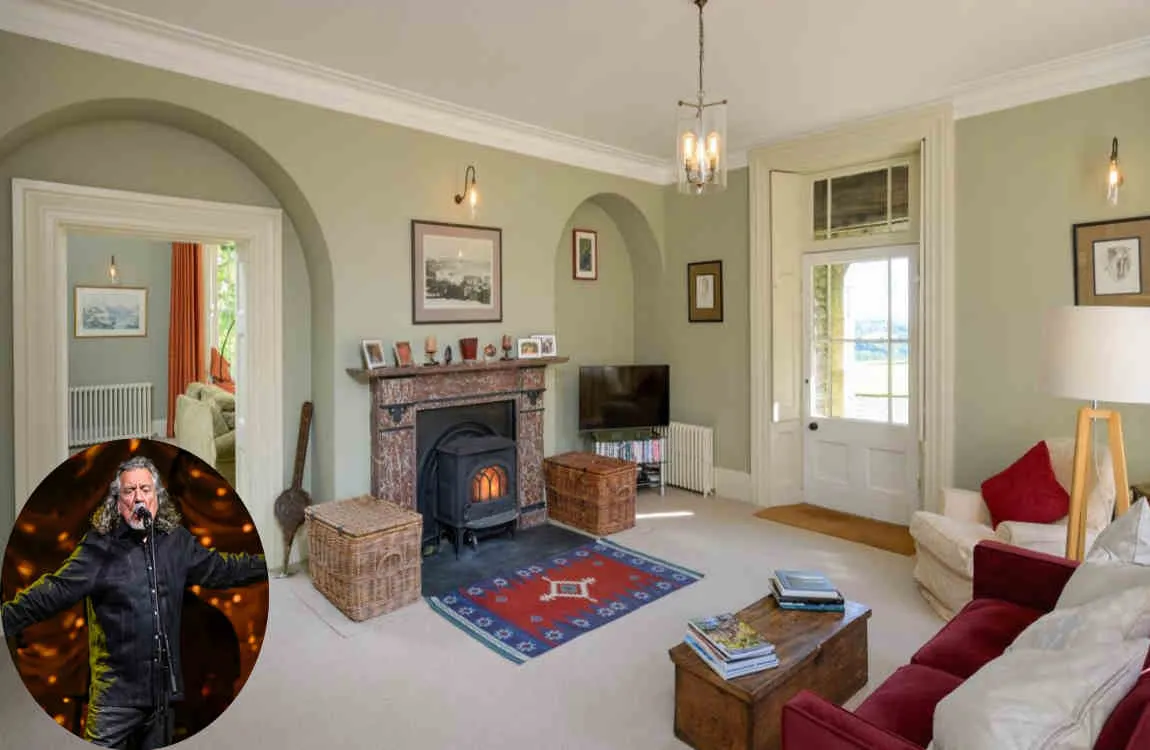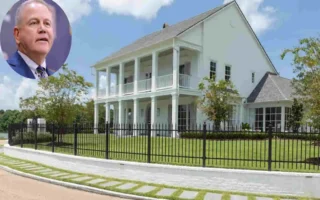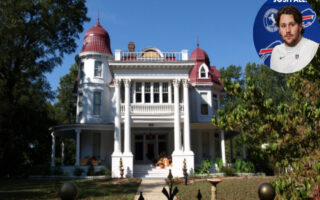Have you ever wondered what it’s like to step inside the home of a rock legend? The Robert Plant house in Austin, Texas, stands as more than just a residence—it’s a living testament to one of rock music’s most influential voices. This extraordinary property captures the essence of the legendary Led Zeppelin frontman’s life, blending artistic expression with personal sanctuary in ways that only a true rock icon could envision.
Robert Plant, whose powerful vocals and charismatic stage presence helped define an entire generation of rock music, has left an indelible mark on the musical landscape. From his groundbreaking work with Led Zeppelin to his successful solo career, Plant has consistently pushed boundaries and redefined what it means to be a rock artist. His influence extends far beyond the recording studio and concert stage, touching every aspect of his life—including his choice of home.
| Category | Information |
|---|---|
| Full Name | Robert Anthony Plant |
| Date of Birth | August 20, 1948 |
| Nationality | English |
| Profession | Musician, singer, songwriter |
| Famous For | Lead vocalist of Led Zeppelin |
| Net Worth (2025) | Approximately $200 million |
| Current Residence | Lives in a Georgian mansion in Shatterford, Worcestershire, England |
The Robert Plant house in Austin represents a fascinating intersection of celebrity culture, architectural innovation, and personal expression. Celebrity homes have always captured public imagination, offering glimpses into the private lives of our cultural icons. They serve as windows into the personalities, tastes, and lifestyles of those who have shaped our artistic landscape. In the case of Plant’s Austin residence, this fascination takes on even greater significance.
Background: Who is Robert Plant?

To truly appreciate the significance of the Robert Plant house, we must first understand the man behind the legend. Born in 1948 in West Bromwich, England, Robert Anthony Plant emerged as one of rock music’s most distinctive and influential voices. His journey from a young blues enthusiast to international superstar reads like a rock and roll fairy tale.
Plant’s rise to fame began in earnest when he joined Led Zeppelin in 1968. Alongside Jimmy Page, John Paul Jones, and John Bonham, he helped create a sound that would revolutionize rock music. His soaring vocals on classics like “Stairway to Heaven,” “Kashmir,” and “Whole Lotta Love” became the gold standard for rock singing. The band’s fusion of blues, folk, and hard rock created a template that countless artists would follow for decades to come.
After Led Zeppelin’s dissolution following Bonham’s death in 1980, Plant embarked on a solo career that demonstrated his versatility and willingness to explore new musical territories. He refused to rest on his laurels, instead pushing himself to experiment with world music, electronic sounds, and alternative rock. This restless creative spirit has kept him relevant and vital throughout his career.
The plant’s connection to Austin developed over years of touring and collaborating with American musicians. The city’s vibrant music scene, with its blend of blues, country, rock, and experimental sounds, resonated deeply with his artistic sensibilities. Austin offered something London couldn’t—a laid-back atmosphere combined with serious musical credibility. The city’s “Keep Austin Weird” ethos aligned perfectly with Plant’s own unconventional approach to life and art.
His decision to establish a home in Austin wasn’t just about geography; it was about finding a place that matched his creative energy. The Robert Plant Austin home became a base for his American adventures. In this place, he could write, record, and collaborate with local musicians while maintaining his privacy and personal space.
Location and Setting of the Robert Plant House
You may also read (discover the charm of blakes house a virtual tour).
| Attribute | Information |
|---|---|
| House Name | Shatterford Grange (Georgian style country house) |
| Location | Shatterford, Worcestershire, near the market town of Kidderminster, England |
| Architecture Design | Georgian Revival Style |
| Year Built | 1935 |
| Structure | Three stories, stately mansion with classical elements such as ionic columns |
| Size | Not explicitly mentioned, but grand with several reception rooms and multiple bedrooms |
| Rooms | Multiple bedrooms, grand reception rooms, and modernized facilities blending old and new |
| Exterior Features | Ivy-clad exterior, imposing facade, classical design details |
| Grounds | Nestled in English countryside, peaceful setting, large garden |
| Worth (Value) | Estimated earlier house purchase was around £500,000; current exact market value not specified |
| History | Originally built in 1935, has changed ownership several times, Robert Plant’s residence for 2+ decades |
| Additional Notes | The house reflects Plant’s preference for rural tranquility and historical character blending with modern living comforts |
| Address | Specific address not publicly disclosed for privacy |
The Robert Plant house sits nestled in one of Austin’s most coveted neighborhoods, where Texas charm meets sophisticated urban living. This area perfectly balances privacy with accessibility, offering the legendary musician a retreat from the spotlight while keeping him connected to the city’s vibrant cultural pulse.
The neighborhood itself tells a story of Austin’s evolution from a sleepy college town to a major cultural destination. Tree-lined streets create natural canopies that provide shade and serenity, while the gentle rolling hills offer stunning views of the Texas Hill Country. It’s a place where you might spot local musicians walking their dogs in the morning or tech entrepreneurs jogging past historic homes that have witnessed Austin’s transformation.
What makes this location particularly special is its proximity to Austin’s legendary music venues. Within a short drive, Plant can access iconic spots like the Continental Club, Antone’s, and the Moody Theater. This strategic positioning allows him to remain connected to the live music scene that initially drew him to Austin while maintaining the distance necessary for creative solitude.
The natural environment surrounding the Robert Plant house plays a crucial role in its appeal. Native Texas oak trees dot the property, their sprawling branches creating organic architecture that complements the artificial structures. The landscape reflects Austin’s unique position at the intersection of several ecological regions, where the blackland prairie meets the Edwards Plateau, creating a diverse and visually striking environment.
From a real estate perspective, this area represents some of Austin’s most valuable property. The combination of location, privacy, and cultural significance makes homes here highly sought after. Properties in this neighborhood rarely come on the market, and when they do, they command premium prices. The presence of celebrity homes like Plant’s only adds to the area’s mystique and desirability.
The setting influences every aspect of the house’s design and daily life. Large windows frame views of the surrounding landscape, bringing nature indoors. Outdoor living spaces take advantage of Austin’s mild climate, creating seamless transitions between interior and exterior environments. This integration with the natural world reflects Plant’s own artistic philosophy, which has always emphasized organic creativity over manufactured perfection.
Architecture and Exterior Features of the Robert Plant House
The architectural design of the Robert Plant house stands as a testament to the marriage of traditional Texas craftsmanship and contemporary artistic vision. Upon first glance, visitors are struck by the home’s ability to command attention while somehow remaining perfectly integrated with its natural surroundings—much like Plant’s own stage presence, which could dominate a stadium while feeling utterly authentic.
The house showcases a fascinating blend of architectural styles that reflect both Austin’s heritage and Plant’s British roots. The primary structure features clean, modern lines softened by natural materials like locally sourced limestone and reclaimed wood. These elements create a dialogue between the contemporary and the timeless, echoing Plant’s own musical journey from blues traditionalist to innovative artist.
One of the most striking exterior features is the expansive front façade, which cleverly uses varying heights and angles to create visual interest without ostentation. Large glass panels punctuate the stone and wood surfaces, allowing natural light to flood the house interior while providing glimpses of the life within. The design philosophy here seems to mirror Plant’s approach to music—transparent in some moments, mysteriously opaque in others.
The Robert Plant house boasts remarkable outdoor spaces that blur the boundaries between architecture and landscape. A series of terraces and patios cascade down the natural slope of the property, each offering different perspectives and purposes. The main terrace, accessible from the living areas, features a stunning infinity-edge design that makes the structure appear to float above the Texas landscape.
Materials play a crucial role in telling the story of this remarkable home. The limestone used throughout the exterior was quarried from the Texas Hill Country, connecting the house to its regional context. Copper accents have been allowed to develop their natural patina, creating an ever-changing color palette that shifts from bright orange to deep green depending on the light and weather. These choices reflect Plant’s appreciation for authenticity and natural aging—concepts central to his musical philosophy.
The craftsmanship evident in every detail speaks to the caliber of artisans involved in the project. Custom metalwork adorns gates and railings, featuring subtle motifs that hint at musical themes without being literal. Stone masons have created walls that seem to grow from the earth itself, using techniques that honor traditional Texas building methods while incorporating modern structural requirements.
Perhaps most telling is how the architecture facilitates the lifestyle of a working musician. A separate entrance leads to the music spaces, allowing collaborators to come and go without disturbing the main living areas. Acoustic considerations have been built into the very bones of the structure, with walls designed to contain sound when needed and release it when desired.
Interior Design and Décor: A Reflection of Robert Plant’s Personality

Stepping inside the Robert Plant house is like entering a three-dimensional autobiography, where every room tells a story and every object holds significance. The interior design masterfully balances rock and roll excess with sophisticated restraint, creating spaces that feel both museum-worthy and utterly livable.
The grand foyer sets the tone immediately, with soaring ceilings that create an almost cathedral-like atmosphere. Here, visitors encounter the first hints of Plant’s eclectic taste—a massive Moroccan chandelier hangs overhead, its intricate metalwork casting dancing shadows on walls adorned with photographs from his travels. The juxtaposition of exotic elements with Texas limestone creates an immediate sense of global sophistication rooted in local context.
Moving into the main living area, the design philosophy becomes clear: this is a home for someone who has traveled the world and brought pieces of it back with him. Vintage Turkish rugs layer over wide-plank oak floors, their rich colors echoing the warm tones found in the Texas sunset. Comfortable seating arrangements encourage conversation and collaboration, with oversized sofas upholstered in buttery leather and scattered with pillows made from vintage rock concert t-shirts—a playful nod to Plant’s history.
The walls serve as galleries for an impressive art collection that spans cultures and centuries. Aboriginal dot paintings hang alongside contemporary British artists, while vintage concert posters from the 1960s and 70s are displayed with museum-quality framing. Each piece has been carefully chosen, not for its investment value but for its personal resonance. A particularly striking installation features gold and platinum records arranged in an abstract pattern, transforming commercial success into an artistic statement.
The kitchen represents a departure from rock star excess, instead embracing a farm-to-table aesthetic that reflects Austin’s food culture. Professional-grade appliances hide behind custom cabinetry crafted from reclaimed Texas mesquite. The massive island serves as both preparation space and gathering spot, its live-edge wood top bearing the scars and stories of countless meals shared with friends and fellow musicians. Open shelving displays a collection of pottery and ceramics gathered from Plant’s travels, each piece a functional art in its own right.
Plant’s personal study offers perhaps the most intimate glimpse into his psyche. Floor-to-ceiling bookshelves hold an eclectic library ranging from beat poetry to botanical guides, reflecting his diverse interests. A writing desk positioned to capture the morning light bears the evidence of ongoing creative work—notebooks filled with lyrics, correspondence with collaborators, and sketches for future projects. The room’s centerpiece is a comfortable reading chair, worn to perfection, positioned next to a table holding a constantly rotating selection of books and vinyl records.
The main bedroom suite continues the theme of global sophistication meeting personal comfort. A massive bed draped in Indian textiles faces windows offering panoramic views of the Texas hills. The color palette here shifts to cooler tones—deep blues and soft grays that promote rest and reflection. Personal photographs line a private hallway, creating a visual timeline of Plant’s journey from Birmingham teenager to international icon.
Throughout the house, musical instruments appear as both functional tools and decorative elements. Guitars rest in custom-built nooks, always within reach for moments of inspiration. A collection of harmonicas fills a vintage display case, while exotic instruments gathered from around the world—sitars, ouds, and African drums—serve as both art objects and reminders of musical explorations.
The Role of Music in the House
At the heart of the Robert Plant house lies its true purpose: serving as a creative sanctuary where musical magic happens. The integration of music spaces throughout the property reflects Plant’s belief that creativity shouldn’t be confined to a single room but should flow freely through every aspect of daily life.
The main recording studio represents the pinnacle of acoustic design married with aesthetic beauty. Unlike the sterile environments of many professional studios, this space feels organic and inspiring. Natural wood panels line the walls, their placement carefully calculated to provide optimal sound diffusion while maintaining visual warmth. The control room features state-of-the-art equipment seamlessly integrated into custom furniture that wouldn’t look out of place in a high-end living room.
What makes this studio unique is its connection to the natural world. Large windows offer views of the surrounding landscape, allowing Plant to maintain visual contact with the outside world while diving deep into sonic exploration. Sliding glass doors open onto a private patio where acoustic performances can spill into the open air, taking advantage of Austin’s mild climate. This indoor-outdoor flexibility has proven invaluable for capturing spontaneous musical moments.
Beyond the main studio, music permeates every corner of the house. A smaller writing room provides an intimate space for composition, equipped with vintage keyboards, a well-worn acoustic guitar, and notebooks dating back decades. The acoustics here favor intimacy over grandeur, creating an environment where whispered melodies can be explored without the pressure of perfection.
The house has witnessed numerous significant musical moments. Collaborations with Alison Krauss reportedly took shape in these rooms, their Grammy-winning partnership finding its voice within these walls. Local Austin musicians speak in hushed tones about late-night sessions where Plant would invite them to explore new sounds, creating musical conversations that bridged generations and genres.
Even the non-musical spaces have been designed with sound in mind. The living room’s acoustics allow for impromptu performances, while the dining room can transform into an intimate venue for acoustic sets. This flexibility means that music can happen anywhere, anytime—a philosophy that aligns perfectly with Plant’s spontaneous approach to creativity.
Unique Features and Hidden Gems of the House
The Robert Plant house holds secrets and surprises that elevate it from a mere luxury residence to something truly extraordinary. These unique features reflect not just wealth but thoughtfulness, creativity, and a deep appreciation for both innovation and tradition.
One of the most intriguing elements is a hidden room accessed through what appears to be a built-in bookshelf. This private sanctuary serves as Plant’s meditation space, its walls lined with acoustic-dampening materials that create profound silence. The room contains minimal furnishings—just cushions, candles, and a small collection of singing bowls. It’s a space for centering and reflection, essential for an artist who has spent decades in the public eye.
Environmental consciousness pervades the property’s design. An extensive solar panel array, cleverly integrated into the roofline to maintain aesthetic appeal, provides much of the home’s energy needs. Rainwater collection systems feed into underground cisterns, supplying irrigation for the extensive gardens. These features reflect Plant’s long-standing environmental advocacy, proving that luxury and sustainability can coexist beautifully.
The outdoor spaces reveal their own treasures. A secret garden, hidden behind a wall of native Texas sage, creates a microclimate where English cottage garden plants thrive alongside desert species. This botanical fusion mirrors Plant’s musical approach—bringing together elements that shouldn’t work but somehow create magic in combination. A small greenhouse extends the growing season, allowing Plant to indulge his passion for horticulture year-round.
Perhaps the most spectacular feature is the custom-designed pool area. Rather than a standard rectangular pool, the design follows natural contours, creating the illusion of a Hill Country swimming hole. Natural rock formations have been incorporated into the design, with some serving as jumping points while others create intimate seating areas. An outdoor shower hidden within a grove of bamboo provides a tropical touch in the Texas landscape.
Technology has been thoughtfully integrated throughout the property. A sophisticated smart home system controls lighting, climate, and security, but the interfaces have been custom-designed to blend with the home’s aesthetic. Voice commands can transform any room into a listening environment, with hidden speakers providing concert-quality sound without visual intrusion.
The Robert Plant House in Popular Media and Public Perception
The mystique surrounding the Robert Plant house has made it a subject of fascination for fans, architecture enthusiasts, and the media alike. While Plant himself maintains a careful balance between public and private life, glimpses of his Austin sanctuary have occasionally emerged, each one adding to the property’s legendary status.
Architectural Digest featured the house in a special issue on musician homes, praising its seamless blend of rock star swagger and sophisticated design. The article’s carefully curated photographs offered tantalizing glimpses while respecting Plant’s privacy, showing just enough to inspire without revealing everything. These images quickly became some of the magazine’s most shared content, demonstrating the public’s enduring fascination with how rock legends live.
Local Austin media have long been intrigued by Plant’s presence in the city. The Austin Chronicle has run several features on the musician’s impact on the local music scene, often mentioning how his home has become an informal salon for musical collaboration. Musicians who have visited speak of it with reverence, describing an atmosphere that encourages creativity and breaks down barriers between established stars and emerging artists.
The house has also influenced Austin’s real estate market and architectural trends. Local designers report increased requests for “Plant-inspired” elements—particularly the seamless indoor-outdoor living spaces and the integration of music rooms into residential design. Real estate agents in the area note that proximity to the Plant residence has become a subtle selling point for nearby properties.
Comparisons to other celebrity musicians’ homes inevitably arise. While some rock star homes scream excess, the Robert Plant house stands apart for its thoughtful design and cultural integration. It shares more DNA with Bob Dylan’s Malibu compound or Neil Young’s ranch than with the ostentatious mansions of pop stars. This distinction reinforces Plant’s position as an artist who has always charted his own course.
Where Does Robert Plant Currently Live?
Robert Plant, the legendary Led Zeppelin frontman, currently lives in a Georgian-style country house called Shatterford Grange, nestled in the peaceful village of Shatterford, Worcestershire, England. This residence is near the market town of Kidderminster and close to the Wyre Forest, a beautiful and quiet area offering green open walks.
You may also read (dave sparks house).




